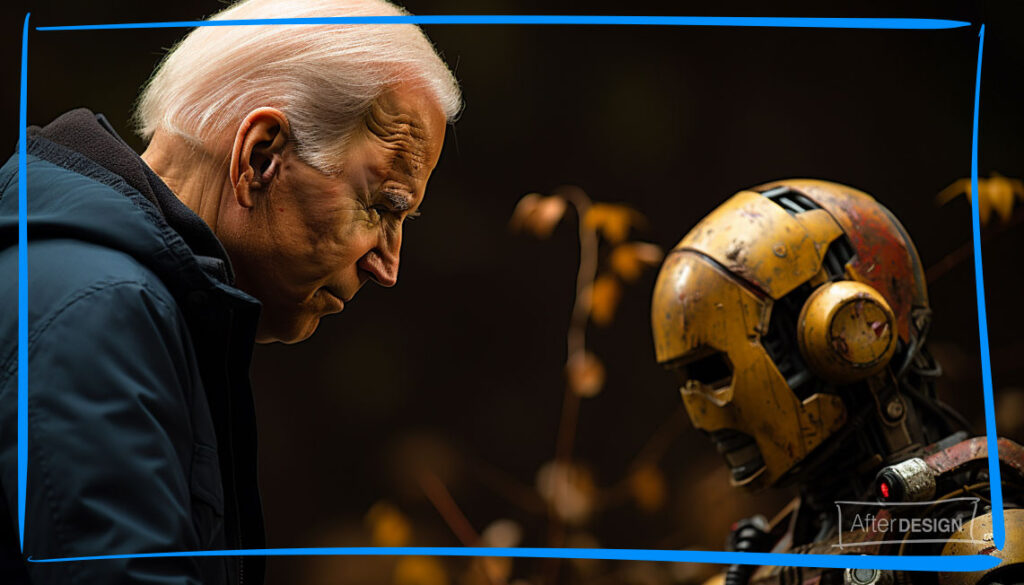President Biden just released a major executive order on AI, and it’s a game-changer, especially for us in the marketing world. This is all about steering AI’s development and keeping an eye on it in the US. It includes new rules to keep consumers safe and make AI companies focus on safety.
The government’s getting its hands dirty too, with the Department of Commerce set to roll out some guidelines for making sure AI-generated content is clearly marked. They’re even tackling how AI is used in the justice system and looking out for workers who might get the short end of the stick because of AI.
Paul Roetzer from the Marketing AI Institute broke it down in his podcast, and here’s the scoop: The order’s got a lot of promise, covering everything from privacy to how AI is going to affect our jobs. But, it’s a bit light on the details. We’re not seeing a lot of action until at least 2025. Unfortunately, this is after next year’s presidential election.
The big focus? Consumer safety. That’s something the government can actually get a grip on, using agencies to enforce the laws we’ve already got.
So, what’s this mean for us marketers? It’s key to get who’s saying what in the AI debate. Paul points out four main camps:
- Doomers, who are all about AI being the end of us;
- Accelerationists, who think fast-paced tech growth is the way to go;
- Big Tech, like Google and Microsoft, who are pushing for these rules but also have their own agenda; and
- Rationalists, who balance pro-tech enthusiasm with real-world ethics.
Paul’s bet is that Big Tech had a big hand in this order. For those of us in marketing, this means keeping an eye on how these rules roll out. It’s going to shape how we use AI to craft our strategies and create killer content.
News at the Intersection of AI and Design

💻 Adobe Created a Symbol to Encourage Tagging AI-Generated Content
Adobe and other tech giants have come together to create a new symbol, acting as a “nutrition label” for AI-generated content. This symbol, part of a broader initiative for content authenticity, aims to provide transparency about the origins and creation of digital media.
- Transparent Origins: The new symbol, which can be added to images, videos, and PDFs, reveals details like ownership, the AI tool used, and other production information, ensuring clarity about the content’s creation.
- Wider Adoption and Impact: Part of the Coalition for Content Provenance and Authenticity’s efforts, this symbol is a step towards standardizing how AI-generated content is identified and authenticated, with companies like Microsoft planning to adopt it soon.
- This article came to me via Karin Abbou
🧐 Our Current Regulations Don’t Work. Do We Have to Think of AI in a Completely New Way?
Last week I attended a panel session at Northeastern University on regulating AI. The panel consisted of a privacy/security lawyer and a philosopher.
- New Way of Thinking: Nothing in our current regulation code fully takes AI’s capabilities into account. We don’t have a box we can shove it in. It’s not data security, it’s not privacy, so what is it?
- Fairness: If we’re forced to think about this in an entirely new way, should we consider fairness? Fairness and the law don’t really co-exist. Is now the time to look through a new prism?
🧑🏽💻 HubSpot’s AI Website Generator: Revolutionizing Web Design
We knew that it was coming sooner or later. Now AI is capable of making websites. By simply answering a few questions about your business, HubSpot’s AI Website Generator can have a custom, single-page site designed in no time, without any coding required.
- Ease of Use: This tool makes website creation a breeze. Just provide some basic information about your business, and the AI takes care of the rest, churning out a custom site that you can then personalize using no-code editing tools.
- Business Growth Support: Not only does it build your website, but it also helps scale your business. With features like SEO content creation, AI-powered email marketing campaigns, and custom landing pages, it’s designed to support your business’s growth.
New Resources for you

A recent article from Business Insider, penned by Emil Skandul, delves into the profound impact AI is expected to have on the job market, particularly distinguishing between the fates of white-collar and blue-collar jobs. It’s a bit of a wake-up call if you haven’t been paying attention.
As AI continues to evolve, it’s anticipated to shake up the white-collar sector significantly, affecting nearly 1 billion knowledge workers globally and potentially eradicating 14 million jobs. This isn’t just a small shift; it’s a seismic change that’s going to redefine the American economy in the coming decades.
But here’s the twist: while those in white-collar jobs might be biting their nails, blue-collar workers could actually be sitting pretty. Jobs that require a mix of physical, knowledge, and social skills – think skilled trades and manual labor – are not only likely to dodge the AI upheaval but are also set for a surge in demand.
This boom is driven by a combination of factors: the retirement of older workers, increasing needs in healthcare, green energy, and high-tech manufacturing, and a growing construction sector. It’s almost like a renaissance for blue-collar roles, a stark contrast to the decline in manufacturing jobs and the shift towards desk jobs since the early 2000s.
The article also highlights a hopeful trend for the working class in the new economy. With industries like semiconductor manufacturing facing a surplus of job openings and a historically tight labor market pushing wages up, there’s a palpable sense of optimism. The U.S. Bureau of Labor Statistics projects that the fastest-growing occupations in the next decade will be in healthcare, transportation, renewable energy, and high-tech manufacturing, with nearly half of all job gains emerging from the healthcare and social-support sectors. This growth isn’t just about numbers; it’s about quality too, offering good work hours, upward mobility, and fair compensation.
So, what does this mean for white-collar workers staring down the barrel of AI disruption? It’s a bit of a reality check. While AI might streamline or even replace certain desk jobs, it’s also augmenting blue-collar roles, making them safer and more productive.
The key takeaway? The AI revolution might not be the job-stealer it’s often painted as – at least not for everyone. For those in blue-collar jobs, it could actually spell a brighter, more secure future.
On the other side of the pond, it’s worth noting the criticism surrounding the UK’s AI safety summit. Critics, including Merve Hickok, President of the Center for AI and Digital Policy, have pointed out the summit’s narrow focus on existential risks of AI, like the hypothetical scenario of Artificial General Intelligence (AGI) taking over.
This emphasis has led to sidelining more immediate and pressing concerns such as bias, equity, fairness, and accountability in existing AI systems. Hickok’s critique highlights a significant gap in the AI safety discourse, suggesting that the summit’s focus might be unduly influenced by major tech companies’ interests, potentially overshadowing other critical threats to civil society.
This situation underscores the need for a more balanced approach to AI policy, one that doesn’t just dwell on distant, speculative dangers but also addresses the tangible, current issues AI poses to fairness and civil rights.
How can I help you?
If you want to learn more about what’s available, here are some links:
Thanks for reading!
-Jim
Want to join hundreds of other designers who are staying ahead of the coming AI wave?
Subscribe now to get the latest in AI and Design in your inbox each week.



